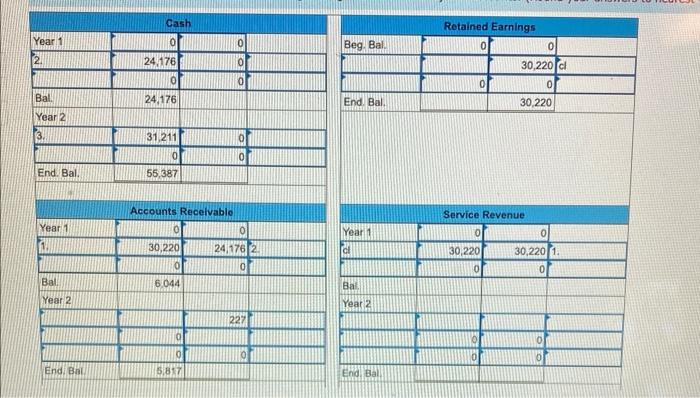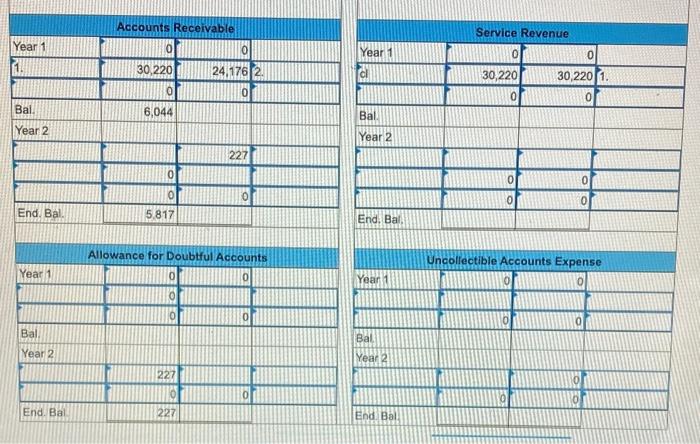Rosie Dry Cleaning was started on January 1. Year 1. It experienced the following events during its first two years of operation Events Affecting Year 1. Provided $30,220 of cleaning services on account 2. Collected $24,176 cash from accounts receivable. 3. Adjusted the accounting records to reflect the estimate that uncollectible accounts expense would be 1 percent of the cleaning revenue on account Events Affecting Year 2 1. Wrote off a $227 account receivable that was determined to be uncollectible. 2. Provided $35,267 of cleaning services on account. 3. Collected $31,211 cash from accounts receivable. 4. Adjusted the accounting records to reflect the estimate that uncollectible accounts expense would be 1 percent of the cleaning revenue on account Required a. Record the events for Year 1 and Year 2 (including closing entries for Year 1) in T-accounts, b. Determine the following amounts: (1) Net income for Year 1 (2) Net cash flow from operating activities for Year 1. (3) Balance of accounts receivable at the end of Year 1. (4) Net realizable value of accounts receivable at the end of Year 1 c. Repeat Requirement b for the Year 2 accounting period Cash Retained Earnings 0 Year 1 0 Beg. Bal. 0 2 24176 0 30,220 ch 0 0 0 Bal 24, 176 End Bal 30,220 Year 2 3 0 31211 0 0 End. Bal. 55,387 Accounts Recelvable 0 Service Revenue Year 1 0 0 Year 1 ol 30,220 0 30,220 1. 30,220 24,1762 0 0 0 0 Ball 6044 Ba Year 2 Year 2 227 a om 0 0 5,817 End. Bol End Bal Accounts Receivable Service Revenue Year 1 0 Year 1 0 0 30.220 24,1762. 30,220 30,220 1. 0 0 0 0 Bal 6,044 Bal. Year 2 Year 2 227 0 0 0 0 o End. Bal 5.817 End: Bal Allowance for Doubtful Accounts Year 1 Uncollectible Accounts Expense 0 O 0 Year 0 0 0 Bal Bal Year 2 Year 2 227 0 End. Bal 227 End Bal Determine the following amounts: (Round your intermediate calculations to nearest whole dollar. (1) Net Income for Year 1. (2) Net cash flow from operating activities for Year 1. (3) Balance of accounts receivable at the end of Year 1. (4) Net realizable value of accounts receivable at the end of Year 1. (1) Net income for Year 1 (2) Net cash flow from operating activities for Year 1 (3) Balance of accounts receivable at the end of Year 1 (4) Net realizable value of accounts receivable at the end of Year 1 Repeat Requirement b for the Year 2 accounting period. (Round your intermediate calculations to (1) Net income for Year 2 (2) Net cash flow from operating activities for Year 2 (3) Balance of accounts receivable at the end of Year 2 (4) Net realizable value of accounts receivable at the end of Year 2











